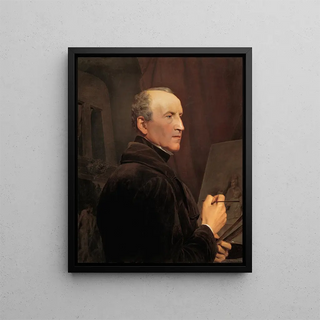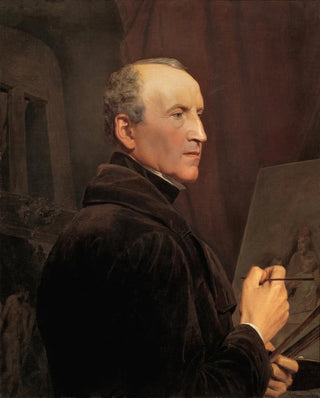Art print Self-portrait in front of the easel - Ferdinand Georg Waldmüller | Art print


View from behind

Frame (optional)
Introduction captivante
The artwork "Autoportrait devant le chevalet" by Ferdinand Georg Waldmüller is a masterpiece that transcends the simple act of self-portrayal. In this painting, the artist does not merely show himself; he engages in a visual introspection that invites the viewer to explore the depths of his soul. The atmosphere emanating from this piece is filled with poignant intimacy, where each brushstroke seems to whisper a personal story. Waldmüller, through his undeniable talent, manages to capture not only his physical appearance but also the very essence of his being. It is this ability to fuse art and emotion that makes this art print so captivating and timeless.
Style and uniqueness of the work
The originality of "Autoportrait devant le chevalet" lies in Waldmüller's distinctive style, which combines realism and romanticism. Every detail is carefully observed, from the textures of the clothing to the nuances of light caressing the artist's face. The background, though understated, plays a crucial role in highlighting the central figure, creating a depth that draws the eye. Waldmüller's posture, leaning over his easel, evokes intense concentration, a passion for his art that resonates with anyone aspiring to creation. This art print is not limited to a simple representation; it is a declaration of intent, an affirmation of artistic identity in a constantly evolving world.
The artist and his influence
Ferdinand Georg Waldmüller is a name that resonates with particular strength in the history of Austrian art. Born in 1793, he distinguished himself through his innovative approach and his ability to capture humanity in all its complexity. Waldmüller is often regarded as a precursor to realism, long before this movement gained significant momentum. His influence extends beyond his contemporaries, inspiring generations of artists to explore themes of introspection and emotion. His work, both personal and universal, continues to fascinate and provoke thought, making him an indispensable figure in the

Matte finish

View from behind

Frame (optional)
Introduction captivante
The artwork "Autoportrait devant le chevalet" by Ferdinand Georg Waldmüller is a masterpiece that transcends the simple act of self-portrayal. In this painting, the artist does not merely show himself; he engages in a visual introspection that invites the viewer to explore the depths of his soul. The atmosphere emanating from this piece is filled with poignant intimacy, where each brushstroke seems to whisper a personal story. Waldmüller, through his undeniable talent, manages to capture not only his physical appearance but also the very essence of his being. It is this ability to fuse art and emotion that makes this art print so captivating and timeless.
Style and uniqueness of the work
The originality of "Autoportrait devant le chevalet" lies in Waldmüller's distinctive style, which combines realism and romanticism. Every detail is carefully observed, from the textures of the clothing to the nuances of light caressing the artist's face. The background, though understated, plays a crucial role in highlighting the central figure, creating a depth that draws the eye. Waldmüller's posture, leaning over his easel, evokes intense concentration, a passion for his art that resonates with anyone aspiring to creation. This art print is not limited to a simple representation; it is a declaration of intent, an affirmation of artistic identity in a constantly evolving world.
The artist and his influence
Ferdinand Georg Waldmüller is a name that resonates with particular strength in the history of Austrian art. Born in 1793, he distinguished himself through his innovative approach and his ability to capture humanity in all its complexity. Waldmüller is often regarded as a precursor to realism, long before this movement gained significant momentum. His influence extends beyond his contemporaries, inspiring generations of artists to explore themes of introspection and emotion. His work, both personal and universal, continues to fascinate and provoke thought, making him an indispensable figure in the
12,34 €






